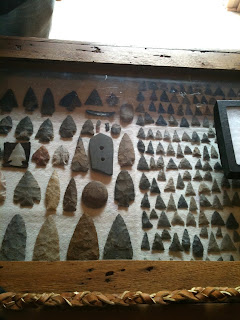Myself holding a pottery shard
The specialist on site is Dr. Robert Wall, a professor at Towson University. He has been inviting his students to work along side him and the Western Maryland Chapter of ASM at the site. Interested locals are more than welcome to volunteer. However, reasons for this hospitality are questionable. I overheard that the more volunteers they have, the less dirt they get to sift through.
The Barton Village Site 18AG3 (18 representing Maryland, AG meaning Allegheny County, and 3 meaning site 3) was purchased from John Barton by the Archeological Conservancy of Albuquerque NM, in 2002 after the Western Maryland Chapter lobbied for its protection for years. Interest in this site increased after a magnetometer survey in 2009 was conducted by Dr. Tim Horsley, an Archeological Geophysicist from the University of Michigan. The findings showed soil disturbance indicating that within the site and on the land located in the flood plains of the Potomac River, were remnants of Native American villages.
The circles in the photo locate the various village sites.
Dr. Wall's previous ambitions for his archeological work consisted mainly on answering questions such as the dietary changes from the late woodland period into the contact period and the types of food processing of these times. Though these questions are still a priority, the finding of a Clovis spear point, a much older form of technology compared to the late woodland period and found mostly near mid-America, has sparked interest given that its age and location of origin seems misplaced in Barton.

Its amazing that anyone discovered the historical value of the site. If not for the curious Domenic family, it may have gone unnoticed. The Domenic family, locals of Barton, discovered the archeological value of the site and their town in general, by picking artifacts thousands of years old, right up off the topsoil. Many of these artifacts are compliments of burrowing type creatures and topsoil churning on farms. John Domenic, the heir of his family's collection and scavenging tendencies, invites everyone he meets to his small museum next to his house to see his vast collection of artifacts, These artifacts range from large ax heads, to tiny shell beads, and even to
 a stranger variety such as his trilobite fossil he
a stranger variety such as his trilobite fossil hethinks a native American carried around with him. The highlight of John's collection is the Clovis spear-point. The finding of such technology sparked the thesis mentioned above, that the professor is working on currently. Hopefully, Dr. Wall will be able to find more of these spear-points and contribute a new theory on the Clovis culture in relation to the people of late Woodland period.
John Domenic and his museum.
The Barton Village Site is amazing and the information about it is abundant, too abundant to fit into this one blog post. However, the important thing about this story is that anyone can experience an archeological dig for themselves. I got to dig through trash 400-500 years old and found pottery shards and animal bones! Think of what you could find.
For information on the Barton Village Site, Dr. Wall's project, and how to get involved, visit these links:
http://www.jefpat.org/archeobotany/ReportPages/18AG119ReportC.pdf
http://sites.google.com/site/wmdasm/home/barton-village-site-18ag3/barton-2008-field-session


No comments:
Post a Comment